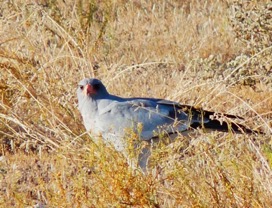Image: Honey badger and black-backed jackal © Keith Somerville
Professor Keith Somerville gets up close and personal with a pugnacious honey badger
The honey badger was purposefully searching among the low bushes near Tau Pan in Botswana’s Central Kalahari Game Reserve. The pugnacious creature credited with great courage and power for its size (max 10kg) was not alone. A pale chanting goshawk was hovering in the sky above, and a black-backed jackalwas trotting a few metres behind.
However, this was no cross-species friendship nor a coincidental meeting. They were following the badger to profit from its foraging
The honey badger, also known as the ratel, is a common sight in Africa’s savanna, woodland and semi-desert habitats, in the Middle East and across southern Asia into the Indian subcontinent. It is omnivorous andhas relatively few enemies – lions and leopards will kill them, jackals are known to predate their young, and humans hunt them for bushmeat and for body parts used in traditional medicine. But they are not defenceless. They have a reputation for aggressively driving off predators, potential threats and even successfully challenging lions and other carnivores, such as hyenas, for their kills. This toughness is why the South African Defence Force under apartheid adopted the name ratel for one of their armoured fighting vehicles.
The political economy of foraging
As well as it ferocity and guts, another legendary aspect of the honey badger’s behaviour is its possibly symbiotic relationship with jackals and hawks – symbiotic relationships between separate species can be commensal (which benefits just one of the species) or true symbiote, which benefits both.
The relationship between the badger, the black-backed jackal and the pale chanting goshawk, which I witnessed on two separate occasions, seems at best commensal (or even directly parasitic). Able to detect rodents, reptiles and insects even underground the badger will use its strong claws and powerful front paws to reach its prey and snap it up. But when the prey is fast or numerous some may escape presenting the waiting hawk and jackal with an opportunity to benefit from the badger’s foraging.
It is hard to see what the badger gains from this regular association, apart from perhaps an early warning system for danger when its safety is compromised while head-down digging furiously. The gains for the jackal and goshawk are clear to see. Other animals and birds such as the Spotted eagle owls and African wildcats, and the Ethiopian wolf or Simien Foxhave also been recorded following and benefitting from badger foraging.
Truly symbiotic or a romantic myth – the honey connection
The other famous relationship connected directly with the badger’s name, concerns honey and how to find it. Bees will create hives in trees, usually, making it harder for badgers to detect, though they do have a very well-developed sense of smell. The badger is said to overcome this through a symbiotic relationship with another bird, the African honeyguide.
This relationship has been observed on numerous occasions. The honeyguides find the hives and use a specific call to alert the badger who break in allowing the honeyguide to eat the larvae found inside and the badger to lap up the larvae-laden honey. A G/wi (San) tracker in the Central Kalahari Game Reserve confirmed that San honey collectors also benefit by seeking out and following the honeyguide.
The accounts of the honeyguide and badger have been challenged by some ornithologists, such as Claire Spottiswoode, who say there is no clear evidence of a relationship and it is a romantic myth based on folktales, anecdotal accounts, and faked YouTube videos. But a recently published paper by Fincham, Peek and Markusin Biodiversity Observations supports the existence of a symbiotic relationship. It cites strong evidence dating back to observations made by James Stevenson-Hamilton, the Kruger National Park’s first warden, and a modern scientificstudy based on more than 3,000 hours of observation of the behavioural development of a young male honey badger at Stone Hills Wildlife Sanctuary, which is close to the Matobo National Park in Zimbabwe.
Fincham, Peek and Markus relate how the two-year study included ‘recorded positive responses from honeyguides to the presence of the badger’ and behaviour that was documented with written notes, photographs and videos. They indicated positive responses to the badger by three different honeyguides. They conclude that, the ‘replicated behaviour by different honeyguides in relation to the badger… implies that the response to the badger’s presence was innate because the birds persisted in attempting to engage his attention…This strong focus by the birds on the badger seems to be compatible with legends that honeyguides lead badgers.’
Not conclusive evidence yet, given it was based on extended study of one animal, but it supports the anecdotal evidence and the evidence of San people who have lived alongside honey badgers for millennia.
What is clear, is that the honey badger is involved in complex and varying relationships with a variety of mammals and birds, which go beyond predator and prey or mere coexistence within the same habitat.
Professor Keith Somerville teaches at the Centre for Journalism, and is a member of the Durrell Institute of Conservation and Ecology at the University of Kent. He is also a senior research fellow at the Institute of Commonwealth Studies (ICWS) at the School of Advanced Study, University of London, and a research associate at the Marjan Centre for the Study of War and the Non-Human Sphere at King’s College, London.
More information
Ivory: a tough choice, but bans aren’t working
Corruption hindering South Africa’s anti-poaching operations
The disappearing cheetah – can Namibia help halt the decline?



